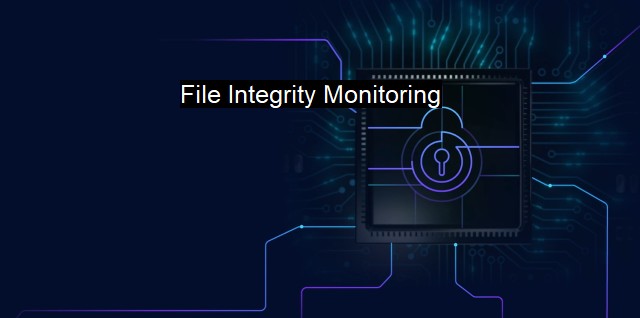What is File Integrity Monitoring?
Understanding the Significance of File Integrity Monitoring for Cybersecurity and Antivirus
File Integrity Monitoring (FIM) is a critical component of managing and securing critical systems, referring to a process that validates the integrity of an operating system as well as application software files, verifying that they have not been altered or manipulated. Traditionally used to ensure regulatory compliance in critical information systems, FIM has increasingly become an essential aspect of advanced cybersecurity workflows due to the escalating sophisticated cybercrime environment.Knowing the importance of FIM begins with understanding that the integrity of systems and data is a cornerstone of information security. Growing cybersecurity threats, combined with escalating legal and industry data protection requirements, mean organizations need to demonstrate a firm handle on their sensitive data. It involves validating and observing the changes in files and directories, identifying who made the changes, highlighting the nature of the changes and determining when these actions were performed.
In the world of information technology, File Integrity Monitoring serves as a layer of security. Its focus is on controlling and securing the extremely sensitive data found in files, databases, servers, or system registries by meticulously monitoring changes. A primary purpose of FIM is to establish a baseline, essentially a secure snapshot of a system's data in its optimal state. Thus, any alterations to this baseline are immediately and keenly detected. Any such change may indicate a virus infiltration, malicious activity, or even a system error.
FIM works by incorporating real-time, or nearly real-time, automated scanning of file systems to analyze core attributes for factors such as alterations in security settings, permissions, content, or size, among other measurable parameters. Importantly, FIM is not solely about detecting changes; it is also about analyzing those traces to distinguish between legitimate changes and potential threats, making it a valued tool in the antivirus arsenal.
Across sectors, FIM tools can help organizations achieve security compliance, as many compliance standards and regulations necessitate thorough logging of system and file-level changes. Organizations operating in regulated industries, such as finance, healthcare, and e-commerce, often require FIM to comply with requirements such as PCI-DSS, HIPAA, SOX, among others.
Another immense advantage of FIM is in its capacity for evidence collection and forensic investigations. By maintaining a record of changes, the FIM assists in determining the extent of an incident, identifying factors that led to a breach, and providing valuable insights into preventing future security threats.
Despite its significance, FIM is not a silver bullet for cybersecurity. It is one aspect of a far more extensive ecosystem intended to safeguard digital assets. For instance, it should be integrated with other robust cybersecurity mechanisms like vulnerability scanning, intrusion detection systems (IDS), antivirus software, and incident response strategies. Combined with these other strategies, FIM can boost a system’s resilience against attacks and minimize potential damage.
There are challenges inherent in implementing FIM. It can be resource-intensive, requiring meticulous management and careful fine-tuning to screen out change "noise" and only alert the security and IT team to significant, potentially malicious alterations. Still, despite these challenges, FIM remains an essential mechanism for modern cyber-defense.
File Integrity Monitoring has evolved to be a fundamental tool for targeted and efficient security. Capable of facilitating both security and compliance, while also enhancing the efficacy of antivirus software, FIM is a flexible solution. Though it presents challenges of its own, with a well-managed implementation, FIM can provide invaluable ongoing monitoring and alerting, serving an significant role in defense-in-depth data protection strategies in any digitally cognizant organization.

File Integrity Monitoring FAQs
What is file integrity monitoring?
File integrity monitoring (FIM) is a security process that continuously monitors and verifies the integrity of system and application files to detect any unauthorized access or modifications. It helps to ensure that critical files are not tampered with or modified without proper authorization.Why is file integrity monitoring important in cybersecurity?
FIM is important in cybersecurity because it helps to detect any unauthorized activities or changes in critical system files that could indicate a security breach or malware attack. It detects changes to not only system files but also configuration files, application files, and other data on a system. This can help prevent data breaches and minimize the impact of attacks.What types of changes does file integrity monitoring detect?
File Integrity Monitoring can detect a wide range of changes including but not limited to changes in file content, file permissions, file ownership, file attributes, file size, and file timestamps.What are some of the benefits of file integrity monitoring?
The benefits of file integrity monitoring include early detection of security breaches or malware attacks, reduction in the duration of an attack, real-time alerts about unauthorized changes, and the ability to report on all detected changes to improve compliance with regulations and company policies.| | A | | | B | | | C | | | D | | | E | | | F | | | G | | | H | | | I | | | J | | | K | | | L | | | M | |
| | N | | | O | | | P | | | Q | | | R | | | S | | | T | | | U | | | V | | | W | | | X | | | Y | | | Z | |
| | 1 | | | 2 | | | 3 | | | 4 | | | 7 | | | 8 | | |||||||